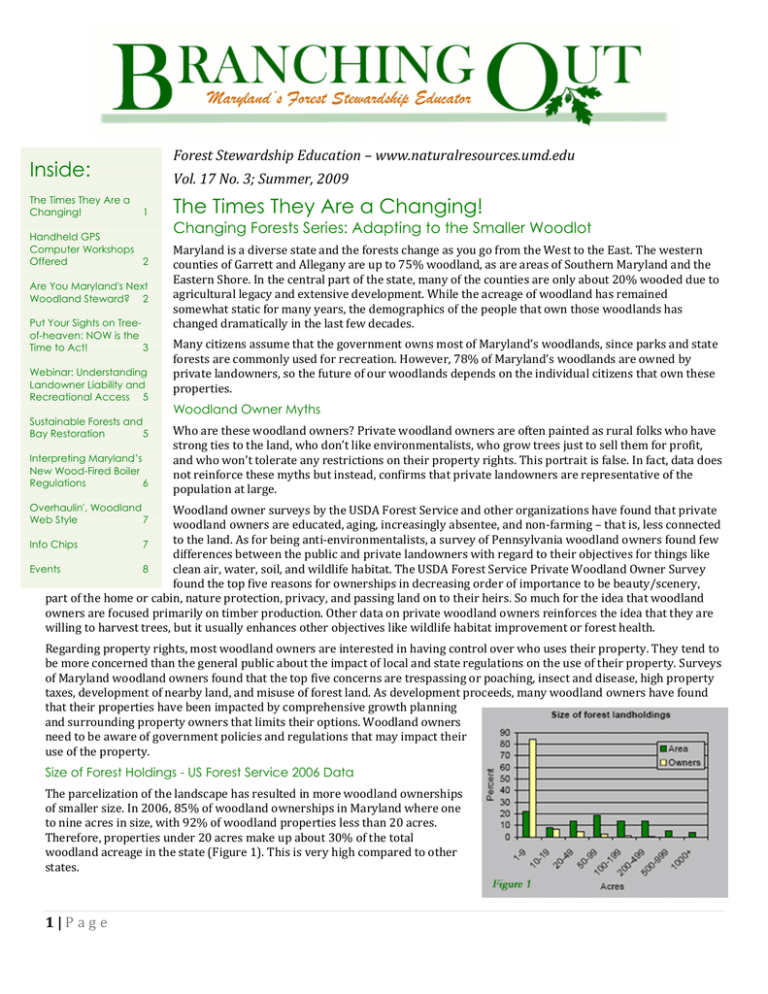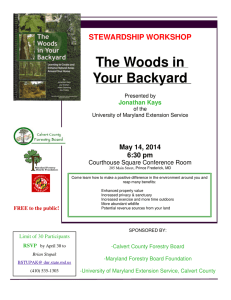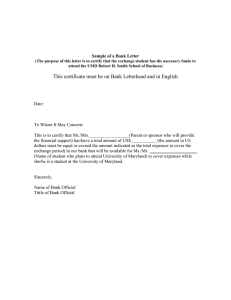Inside: The Times They Are a Changing!
advertisement

Forest Stewardship Education – www.naturalresources.umd.edu Inside: The Times They Are a Changing! Vol. 17 No. 3; Summer, 2009 1 Handheld GPS Computer Workshops Offered 2 Are You Maryland's Next Woodland Steward? 2 Put Your Sights on Treeof-heaven: NOW is the Time to Act! 3 Webinar: Understanding Landowner Liability and Recreational Access 5 Sustainable Forests and Bay Restoration 5 Interpreting Maryland’s New Wood-Fired Boiler Regulations 6 The Times They Are a Changing! Changing Forests Series: Adapting to the Smaller Woodlot Maryland is a diverse state and the forests change as you go from the West to the East. The western counties of Garrett and Allegany are up to 75% woodland, as are areas of Southern Maryland and the Eastern Shore. In the central part of the state, many of the counties are only about 20% wooded due to agricultural legacy and extensive development. While the acreage of woodland has remained somewhat static for many years, the demographics of the people that own those woodlands has changed dramatically in the last few decades. Many citizens assume that the government owns most of Maryland’s woodlands, since parks and state forests are commonly used for recreation. However, 78% of Maryland’s woodlands are owned by private landowners, so the future of our woodlands depends on the individual citizens that own these properties. Woodland Owner Myths Who are these woodland owners? Private woodland owners are often painted as rural folks who have strong ties to the land, who don’t like environmentalists, who grow trees just to sell them for profit, and who won’t tolerate any restrictions on their property rights. This portrait is false. In fact, data does not reinforce these myths but instead, confirms that private landowners are representative of the population at large. Overhaulin', Woodland Web Style 7 Woodland owner surveys by the USDA Forest Service and other organizations have found that private woodland owners are educated, aging, increasingly absentee, and non‐farming – that is, less connected to the land. As for being anti‐environmentalists, a survey of Pennsylvania woodland owners found few Info Chips 7 differences between the public and private landowners with regard to their objectives for things like Events 8 clean air, water, soil, and wildlife habitat. The USDA Forest Service Private Woodland Owner Survey found the top five reasons for ownerships in decreasing order of importance to be beauty/scenery, part of the home or cabin, nature protection, privacy, and passing land on to their heirs. So much for the idea that woodland owners are focused primarily on timber production. Other data on private woodland owners reinforces the idea that they are willing to harvest trees, but it usually enhances other objectives like wildlife habitat improvement or forest health. Regarding property rights, most woodland owners are interested in having control over who uses their property. They tend to be more concerned than the general public about the impact of local and state regulations on the use of their property. Surveys of Maryland woodland owners found that the top five concerns are trespassing or poaching, insect and disease, high property taxes, development of nearby land, and misuse of forest land. As development proceeds, many woodland owners have found that their properties have been impacted by comprehensive growth planning and surrounding property owners that limits their options. Woodland owners need to be aware of government policies and regulations that may impact their use of the property. Size of Forest Holdings - US Forest Service 2006 Data The parcelization of the landscape has resulted in more woodland ownerships of smaller size. In 2006, 85% of woodland ownerships in Maryland where one to nine acres in size, with 92% of woodland properties less than 20 acres. Therefore, properties under 20 acres make up about 30% of the total woodland acreage in the state (Figure 1). This is very high compared to other states. 1 | P a g e What is more revealing is how the trend toward smaller ownerships has accelerated over the last decades. Figure 2 shows that ownerships 1‐9 acres in size, only made up 55% of the total in 1976 (about 4% of the total forested acreage). In 2006, 85% of the ownerships are now 1‐9 acres in size. The parcelization of the landscape is a reality, and while the average size of private woodland parcels is larger in the more rural areas of the state, the trend is undeniable. The size of forest holdings continues to shrink as larger properties are parcelized. The trend toward smaller acreages makes it more difficult for woodland owners to find foresters or loggers to work on their properties to improve forest health and accomplish other wildlife objectives. A greater challenge is providing education to small acreage woodland owners who are unfamiliar with the resource they own and are unsure how to carry out practices that will enhance their property. The University of Maryland Extension program, The Woods in Your Backyard, is one attempt to provide this education. In addition to educating landowners, there is also the need to identify service providers, such as foresters, loggers, arborists, landscapers, etc., who are willing to work with this clientele. Future newsletter articles will provide innovative solutions to address some of these challenges. Handheld GPS Computer Workshops Offered Handheld GPS receivers are a great resource for landowners, natural resource professionals, and other outdoor recreationalists. Current GPS units are accurate (+/‐ 15 feet) and can be used for marking hunting locations, structures, streams, your vehicle location, as well as for fun activities such as geocaching. Professional natural resource managers can save valuable field time by using GPS with a computer to locate inventory plots, access roads, outline timber sale and property boundaries, direct customers to sale locations, and much more. The University of Maryland Cooperative Extension is again offering a series of fall workshops for Beginner GPS Training to teach those interested in learning how to use GPS handheld receivers with a computer, with applications specific to forestry and logging uses. Workshops run from 9 a.m. to 3:30 p.m. and the cost is $55. GPS units and laptops are available for use. Workshops are being offered at the following locations: Location: Western Maryland Research & Education Center 18330 Keedysville Road Keedysville, MD 21756 Contact Pam Thomas (pthomas@umd.edu) 301‐432‐2767 x315 October 27 – Beginner GPS Training October 29 – Integrating Terrain Navigator and GPS: An Affordable, Easy‐to‐Use System Location: Wye Research & Education Center 124 Wye Narrows Drive Queenstown, MD 21658 Contact Carol Taylor (carolt@umd.edu) 410‐827‐8056 November 3 – Beginner GPS Training November 5 – Integrating Terrain Navigator and GPS: An Affordable, Easy‐to‐Use System November 10 (tentative) – Beginner GPS Training (Being held at University of Maryland, College Park) For more information about GPS, please visit: http://www.naturalresources.umd.edu/EducationalGPS.html Are You Maryland’s Next Woodland Steward? We can help you decide. Learn about Maryland Woodland Stewards (MWS) by viewing a recently recorded webinar* by Extension Specialist Jonathan Kays and Forestry Educator Nevin Dawson. Topics include: 2 | P a g e The State of Forests in Maryland Background of MWS Importance of MWS Testimonial by Don and Linda Grove, Maryland Woodland Stewards since 1990 Review of Workshop Agenda And more… To view webinar, visit: https://connect.moo.umd.edu/p49269544/ *This webinar was recorded using Adobe Connect and requires Adobe Flash Player. Download Adobe Flash Player for free from http://get.adobe.com/flashplayer/ To apply or nominate someone else for this program, please contact Nevin Dawson by email or phone at ndawson@umd.edu | 410‐827‐8056 x125. Maryland Woodland Stewards Training September 17—20 Camp Pecometh Centreville, MD Put Your Sights on Tree-of-Heaven: Now is the Time to Act! Tree of heaven, also known as ailanthus or stinking sumac (because of the burned nut odor when cut) is a fast‐growing deciduous tree that produces many seeds. As many land owners have found, it can take over sites, replacing native species and forming dense thickets (Figure 1). The challenge is how to control it most effectively. Late summer and fall is the time to act to control ailanthus with herbicides. First, we need to properly identify it and learn a little about its ecology. Where Did It Come From? Tree of Heaven was originally brought into the US from China by a gardener in Philadelphia, PA in 1784, and by 1840 was commonly available from nurseries. It was also brought into California by the Chinese during the gold rush of in the mid‐1940’s. The ability of the tree to grow in disturbed urban areas where it sprouts up anywhere, is a redeeming value. For example, the book, “A Tree Grows in Brooklyn,” by Betty Smith, is based on the tree‐of‐heaven. Away from the cities, ailanthus is commonly seen in fields and along roadsides, fence rows, wooded edges, and even in forest openings in wooded areas. Ailanthus is reported to be invasive in natural areas in 30 states, which includes all of the northeast states. Characteristics Ailanthus has smooth stems with pale gray bark. Its large compound leaves are 1‐4 feet in length, alternate on the stem, and composed of 10‐41 smaller leaflets. It is important not to confuse native species such as sumac, ash, hickory, and black walnut which have toothed leaf margins completely around each leaflet. Each leaflet of ailanthus has one or more glandular teeth along the lower margin but otherwise, it lacks teeth (Figure 2). Being so fast growing, a person may think the wood would have some value for wood products such as boards or firewood. No hope there. The wood is soft, weak, course‐ grained, has a foul odor, and burns very quickly. While it may have some value for pulp or wood biomass, there is little interest in large scale cultivation due to its invasive nature. Ailanthus reproduces both sexually (by seeds) and asexually through vegetative sprouting. Ailanthus also produces chemicals that prevent the establishment of other plant species nearby. Male and female flowers are found on separate plants. Flowers occur in large terminal clusters and mature into flat, twisted, winged fruits in late summer or early fall, and persist into winter. Each tree can produce as many as 325,000 seeds per year. Unfortunately, the seeds have little wildlife value ‐ deer have no interest nor do even small creatures. 3 | P a g e When an area is disturbed the seeds of ailanthus will germinate and many times outgrow the native species. However, it is the vegetative sprouting of tree of heaven that creates the greatest challenge to management. When cut, the stump will produce vigorous sprouts like many other deciduous trees, however, it is the root sprouting that presents the greatest challenge in many cases. Root sprouts can emerge from up to 50 feet from the nearest existing stem and cover the ground quickly. Management Recommendations Elimination of ailanthus requires diligence and persistence due to its abundant seed production, high seed germination rate, and vegetative reproduction. While manual removal or mechanical cutting is attempted, they typically fail unless herbicides are used to control the resprouting. Follow‐up monitoring and treatment must be an integral part of any serious ailanthus management program. Regardless of method selected, treated areas should be rechecked one or more times a year and any new suckers or seedlings treated (cut, sprayed or pulled) as soon as possible, especially before they are able to rebuild root reserves. Establishing a thick cover of trees (non‐invasive and preferably native) or grass sod will help shade out and discourage establishment of ailanthus seedlings. Targeting large female trees for control will help reduce spread of ailanthus by seed. Now is the Time to Use Herbicides The most effective method of ailanthus control is through the use of herbicides, which may be applied as a foliar (to the leaves), basal bark (12‐18” up the trunk from the ground), cut stump (around the outer layers of the stump after cutting), or hack and squirt treatment (making cuts around the trunk and squirting in the herbicide). Late summer and fall is the most effective time to use herbicides, since during this time food produced in the leaves is being actively transported and stored in the roots for growth the following spring. When the herbicide is applied to the leaves, wood or bark, it is moved deep into the root system where it disrupts its growth and eliminates resprouting. Keep in mind that it is relatively easy to kill the above ground portion of ailanthus trees, but you need to kill or seriously damage the root system to prevent or limit stump sprouting and root suckering. Always be extremely careful with herbicide applications in the vicinity of valuable ornamental shrubs and trees. Two Common Herbicides The two most effective and accessible chemicals for controlling ailanthus and many other invasives are glyphosate and triclopyr. Glyphosate is a non‐selective herbicide that will kill almost any plant, herbaceous or woody, contacted by the spray. It is sold in most home and garden stores under the tradename Roundup®, Rodeo®, Accord®), however, there are several other generic brands of the same chemical that may be cheaper (around $40 per gallon for concentrate). Triclopyr (e.g., Garlon® 3A, Garlon® 4) is selective for broadleaf and woody plants and will not kill grasses contacted by the spray. It is only available from agrochemical suppliers and forest supply companies and only sold in 2.5 gallon containers. Prices can range from $80 per gallon from a company such as Arborchem Products (www.arborchem.com) to $136 per gallon from forestry suppliers (http://www.forestry‐suppliers.com), so look around. Both glyphosate and triclopyr are systemic herbicides, meaning that they are absorbed by plants and are carried to the root systems. These herbicides have low soil activity, so do not pose a threat to groundwater if applied properly and at recommended label rates. While glyphosate is easier to get, Garlon® is a more effective chemical against root sprouting. As with all herbicides, READ THE LABEL, and whatever you need to know is there. More specific herbicide recommendations to control ailanthus can be found in the publication, Tree‐Of‐Heaven Control by Phillip Pannill, available free for download at http://www.naturalresources.umd.edu/Publications/PDFs/Other/TreeOfHeaven.pdf. The publication by Penn State entitled, Herbicides and Forest Vegetation Management: Controlling Unwanted Trees, Brush, and Other Competing Forest Vegetation provides excellent pictures of techniques. As with all herbicides, it is suggested that landowners contact their local University of Maryland Extension office to get a private herbicide applicators license. The following resources support this article and provide more information: Plant Conservation Alliance, Alien Plant Working Group http://www.nps.gov/plants/alien/fact/aial1.htm The Ohio State University Fact Sheet F‐65‐09 ‐ Controlling Non‐Native Invasive Plants in Ohio Forests: Ailanthus http://www.ohiodnr.com/LinkClick.aspx?fileticket=DGFKenByJHA%3d&tabid=21391 4 | P a g e Upcoming Webinar: Understanding Landowner Liability and Recreational Access September 10, 2009—12:00 to 1:00 p.m. ‐ Registration required. Many landowners are confused about their liability for hunters and other recreationalists that use their property. Concerned private landowners increasingly face questions such as: What are my rights, and how do I exercise them to control recreational use of my property? What is the extent of my liability to recreationalists, and how can I protect myself against liability suits? What are my options for posting my land and controlling trespass by recreationalists? How do these options affect my liability? How do I charge for recreational access and still provide liability protection? What do I do if someone takes timber from my property without permission? The answers to these questions can be complicated. However, it is very helpful for landowners to understand the laws related to landowner liability and trespass, and the safeguards that minimize liability so you can make informed decisions regarding the use of your land by others for recreational activities. This one hour webinar being offered free of charge at 12 noon on September 10 will explain the Maryland Annotated Code in a way that you can understand and apply it to common situations faced by landowner and recreationalists. The intention is to suggest easy and (usually) inexpensive methods by which landowners can protect themselves. The speaker for the webinar is Jonathan Kays, Natural Resources Specialist with the University of Maryland Extension. He is the author of recently revised publication entitled, Recreational Access and Landowner Liability, (Bulletin EB357). The 37‐page publication will provide a valuable reference for those attending the webinar or for those that just want to read on their own. It is available free for download at http://extension.umd.edu/publications/PDFs/EB357.pdf. There is no charge for participation, but registration is required. An Email communication with webinar details (website address) will only be sent to people who have registered. Connection details are sent about two days before the webinar. You can register up until about 2 hours before the conference begins. To register for the webinar, contact Pam Thomas at pthomas@umd.edu or 301‐432‐2767 x315. Sustainable Forests and Bay Restoration Revised from: Sustainable forests at the root of achieving Bay's restoration; Gary Allen; Bay Journal - Alliance for the Chesapeake Bay Maryland gained forefront status in the Bay watershed on May 7 with the signing into law of Senate Bill 549‐the Sustainable Forestry Act of 2009‐sponsored by Sen. Roy Dyson. This act is designed to realize one goal‐the retention of privately owned forest lands within Maryland consistent with and responsive to the 2007 Forestry Conservation Initiative signed by the Chesapeake Bay Executive Council in December 2007. In short, the cure for the ills plaguing our Chesapeake Bay can be found in our trees. Maryland clearly recognizes this with its enactment of the Sustainable Forestry Act. It is a historic act that should serve as a model not only within the Bay watershed, but from a national perspective as well. A key argument for moving the bill emanated from the Chesapeake Bay Council's Directive No. 06‐1, "Protecting the Forests of the Chesapeake Watershed," on Sept. 22, 2006 which reads: "Retaining and expanding forests in the Chesapeake Bay watershed is critical to our success in restoring the Chesapeake Bay. Forests are the most beneficial land use for protecting water quality, due to their ability to capture, filter and retain water, as well as absorb pollution from the air...a reduction in forest area leads to a disproportionate increase in nitrogen loads to our waterways." On Dec. 5, 2007, the Chesapeake Bay Council issued a "Call to Action" by building on its earlier decision to underscore the importance of promoting sustainable forestry within the Chesapeake Bay watershed, stating: "Chesapeake forests prevent millions of pounds of nitrogen and other pollutants from reaching the Bay each year.” "Retaining and expanding forests across the watershed is a cost‐effective strategy for reducing pollution now and maintaining caps on nutrients in the future.” 5 | P a g e "An investment in sustainable forestry will not only help to address water quality issues but other challenges such as climate change, sprawl and energy independence.” "Therefore, it is our intent to maximize the area of forest by discouraging the conversion of the most valuable forests and giving priority to forests in land conservation programs. Further, we recognize the importance of working forests and will ensure that public policies and market‐based incentives help families retain and manage these forests sustainably." So, what does the Sustainable Forestry Act of 2009 actually accomplish? Provisions of the Act include but are not limited to: Declares tree and forest cover as the single most beneficial land use for protecting the Chesapeake Bay Directs retention of privately‐owned forest lands under Maryland’s land conservation programs Incorporates recognition of sustainable forestry management in local land use master plans Enhances forest land preservation under Maryland’s Agricultural Land Preservation Foundation Establishes a Right to Practice Forestry in Maryland without undue legal interference Delineates comprehensive definitional terms attendant to forestry and related practices Creates the Sustainable Forestry Council within the Department of Natural Resources Expands the purposes of the Woodland Incentives Fund Authorizes timber revenues derived from State lands to be credited to the Woodland Incentives Fund Advances urban tree canopy funding strategies Permits Forest Conservancy District Boards to become fiscally self‐sufficient Sets forth innovative future strategies from renewable energy production to tax incentives In the final analysis, it is imperative that Maryland retain its forests. This is made especially difficult because 76% of Maryland's 2.4 million acres of forested lands are owned by private landowners who can exercise their private property rights to dispose of or manage such lands at will. Development pressure is real. Compounding this is the realization of Maryland's prevailing fiscal condition, meaning, millions of additional dollars are not available to help conserve the state's vanishing forests through desperately needed financial incentives. In short, Maryland's forests are truly at risk and the Sustainable Forestry Act of 2009 will help to mitigate this threat through creative strategies today that will produce measurable dividends to the state's "green infrastructure" tomorrow. Interpreting Maryland’s New Wood-Fired Boiler Regulations The unease over the cost of oil and gas has led many homeowners to install, or consider installing, wood‐fired boilers for heating and hot water needs in the winter as well as year‐round. Small wood‐fired boilers are of particular concern to the Maryland Department of Environment (MDE) because stack emissions are higher than other wood burning appliances, resulting in an increase in particulate emissions. New lower emission boilers have been developed, but the older boilers were found to be illegal. An article in the Fall 2008 issue of Branching Out indicated the MDE hosted stakeholder meetings to discuss the growing issue over small wood‐fired boilers. As a result of this process, a new regulation was developed an included in the Code of Maryland Regulations (COMAR). The new regulation can be viewed online by searching COMAR at http://www.dsd.state.md.us/comar/comar.aspx (search article 26.11.11 Control of Particulate Matter from Small Wood Boilers). Reading this regulation can be confusing but after some discussion with MDE personnel the following major points are identified: As of April 1, 2009, all stoves sold, installed, distributed, or manufactured in the State must meet new stringent emission requirements and have a particulate matter emission of 0.6 pounds per million BTU input, and a particulate matter emission standard of 0.32 pounds per million BTU heat output by April 1, 2010. This really puts the pressure on manufacturers to provide these products for sale. A person owning or operating a small wood boiler that was purchased before April 1, 2009 can still operate their stove but there are some restrictions on the types of fuel that must be used. They can use clean wood and wood pellets, but there is a list of unacceptable fuels such as garbage, tires, lawn clippings, yard waste, plastic, rubber, etc. The willingness of MDE to allow existing stoves to operate was based on input from manufacturers that found there was no type of add‐on they could provide to reduce the emissions, and to disallow existing stoves would be an economic hardship to many people who have them in use. The counties do have the ability to impose additional regulations on small wood‐fired boilers, as they do with all state regulations, that would require additional steps by the owner. 6 | P a g e While not stated specifically in the regulation, conversations with MDE personnel found that the operation of an existing wood boiler could be effected if it was a nuisance or created a public health problem. As many people know, it is possible that a dispute between neighbors can arise and a neighbor could file a nuisance or public health complaint against another for retribution. These types of complaints are commonly handled by county and/or MDE personnel depending on the county. Of the many complaints filed for wood fired boilers, only 1 or 2 ever resulted in an enforcement action, according to an MDE employee familiar with the regulation. Usually the parties are brought together and reasonable solutions are found. The stakeholder process that developed the new regulations had the involvement of county personnel, but it is possible that some counties may be unaware of this new regulation. Some may just think outdoor small wood‐fired boilers are illegal, period. If you are a landowner with an interest in this issue, get a copy of the regulation and share it with your county personnel. If you need clarification, contact the MDE (410‐537‐3000). Overhaulin', Woodland Web Style Woodland owners will have an easier time getting their forest‐related questions answered and finding the information they needs thanks to an improved website developed by the University of Maryland Extension (UME): http://www.naturalresources.umd.edu “78% of Maryland forest land is in the hands of private landowners,” says MCE natural resources specialist Jonathan Kays. “To ensure the continued success and existence of this vital natural resource, it’s critical that we help these individuals manage their land wisely. One way of doing that is through a comprehensive, easy‐to‐use website.” According to Kays, the goal was to completely overhaul the existing Forest Stewardship Education website to make it easier for people to get the information they need quickly and easily. The work was user‐driven, relying heavily on feedback from some of Maryland’s nearly 400 woodland stewards. The result: a clean, attractive, dynamic online resource. Media contacts for more information: Jonathan Kays, 301 432‐2767 ext. 323 jkays@umd.edu Nevin Dawson, 410‐827‐8056 ext. 125 ndawson@umd.edu Ellen Green, 301 432‐2767 ext. 307 egreen13@umd.edu Info Chips Publications Now Available! Timber Tax Management for Family Forest Owners 2009 Edition for Filing 2008 Tax Returns William L. Hoover and Mark Koontz To order, call Timber Tax directly at 208‐855‐2081 or visit http://www.timbertaxadvice.com Estate Planning for Forest Landowners: What Will become of Your Timberland? William c. Siegel, Harry L. Haney, Jr., and John L. Greene The publication is available online and by hard copy. Please visit http://www.srs.fs.fed.us/pubs/31987 Hard copies are also available at our office. Contact Pam Thomas at pthomas@umd.edu / 301‐432‐2767 x315 (there will be a small fee for postage) Broadleaved Shrubs and Shade Trees—Problems, Picture Clues, and Management Options Mary Kay Malinoski and David L. Clement both of the University of Maryland Extension. Available for purchase from Natural Resource, Agriculture, and Engineering Service (Publication NRAES‐183) http://www.nraes.org. 7 | P a g e Events 9/1/09: General Forestry Course ‐ Online and paper versions. University of Maryland Extension. Contact Nancy Stewart at nstewar1@umd.edu or 410.827.8056, ext. 112. Cost is $300, $400 for late registration. This course is designed for individuals who wish to increase their knowledge of forests and forest management. No prerequisites, non‐credit, earn a certificate of completion. Design a forest management plan framework for your property. The course discusses forest history, policy, ecology, tree ID, fire, silviculture, the business of forestry, forest management and much more. For more information, visit: http://www.agnr.umd.edu/extension/elearning/generalforestry/ 9/10/09: Webinar: Understanding Landowner Liability for Hunting, ATV’s, Firewood Cutting, and Recreational Access. 12:00 to 1:00 p.m. Registration required. To register, email Pam Thomas at pthomas@umd.edu or call 301‐ 432‐2767 x315. See complete article in this newsletter. 9/15/09 & 9/29/09 ‐ 7:00 p.m.: Woods in Your Backyard Workshop; University of Maryland Extension, Carroll County Office; Westminster, MD. For more information and to register, contact Steve Allgeier, Master Gardener Coordinator by phone 410‐386‐2760 or email hortman@umd.edu. 9/17/09 to 9/20/09: 2009 Maryland Woodland Steward Training: Camp Pecometh, Centreville, MD. To register, contact Nevin Dawson by email (ndawson@umd.edu) or by phone (410‐827‐8056 x125). http://www.naturalresources.umd.edu/EducationalMWS.html 9/23/09 to 9/30/09: Being held in Washington, D.C. this fall, the 2009 National Tree Farmer Convention has the potential to be the most influential event in Tree Farm history. To register, go to http://www.treefarmsystem.org. On the home page, click on convention logo. Or, contact Amy Yambor by phone 202‐463‐5172 or email ayambor@forestfoundation.org. The deadline for registration is September 4, 2009. Walk‐ins are not permitted. General public rates are $275.00 before August 3, 2009 / $295.00 afterwards. 10/5/09: Save the date! Forestry Summit ‐ Influence Maryland forest‐related policy. Maritime Institute, Linthicum Heights, MD. $25, includes lunch. Registration information coming soon. 10/6/09 & 10/13/09 ‐ 6:00 to 9:00 p.m.: (Tentative) Woods in Your Backyard Workshop; University of Maryland Extension, Harford County Office; Westminster, MD. For more information and to register, contact Craig Highfield, Program Manager—Forestry for the Bay, at 410‐267‐5723 or chighfield@chesapeakebay.net 10/24/09: Save the date! Forest Landowner Workshop. Dorchester 4‐H Camp, Cambridge, MD. Registration information coming soon. 10/27/09: Beginner GPS Training; Western Maryland Research & Education Center; Keedysville, MD. See GPS article in this newsletter. 10/29/09: Terrain Navigator and GPS; Western Maryland Research & Education Center; Keedysville, MD. See GPS article in this newsletter. 11/3/09: Beginner GPS Training; Wye Research & Education Center; Queenstown, MD. See GPS article in this newsletter. 11/10/09: Beginner GPS Training; Wye Research & Education Center; Queenstown, MD. See GPS article in this newsletter. 11/5/09: Terrain Navigator and GPS; Wye Research & Education Center; Queenstown, MD. See GPS article in this newsletter. Branching Out University of Maryland Extension | 18330 Keedysville Road | Keedysville, MD 21756-1104 | 301-432-2767 Editors: Jonathan Kays, Ellen Green, Nevin Dawson, and Denni Johnson Published four times per year and distributed to forest landowners, resource professionals, and others interested in forest stewardship. To Subscribe: Email Notification: To be notified by email when new issues become available, email listserv@listserv.umd.edu. In the body of the message, type SUB branchingout your name (ex: SUB branchingout John Doe). Hardcopy subscription, mail check or money order for $10 per year, payable to University of Maryland to the address above. Online: Issues are posted online and can be downloaded for free: http://www.naturalresources.umd.edu Send news items to Nevin Dawson at ndawson@umd.edu or 410-827-8056 x125. Equal Access Programs 8 | P a g e





